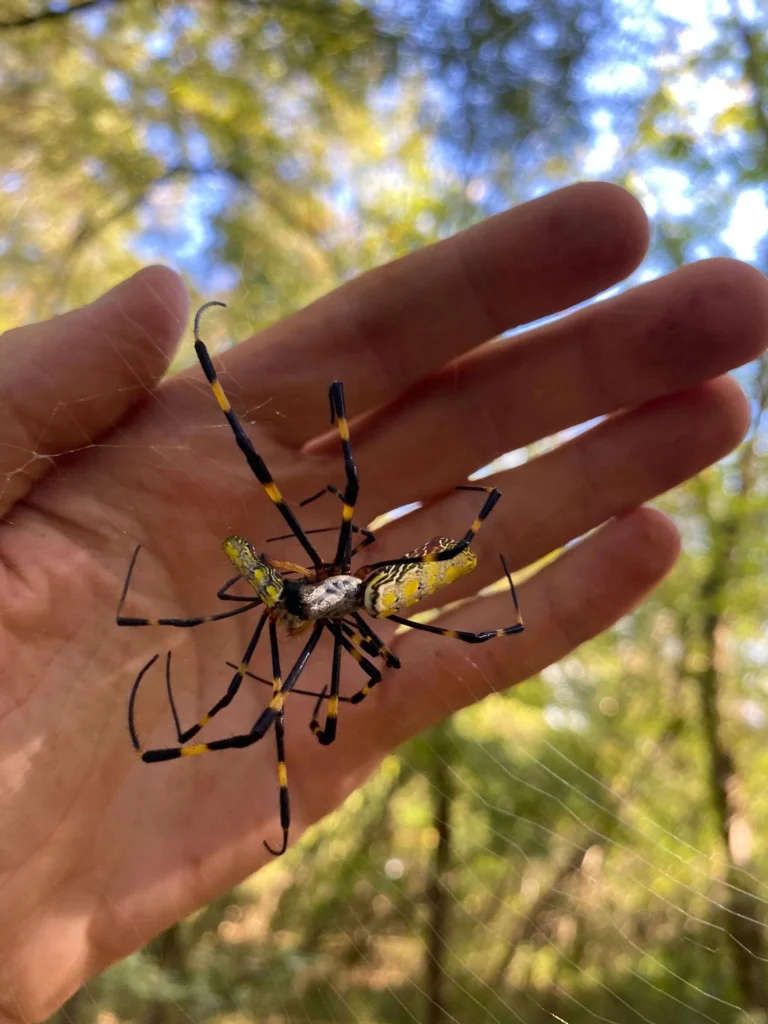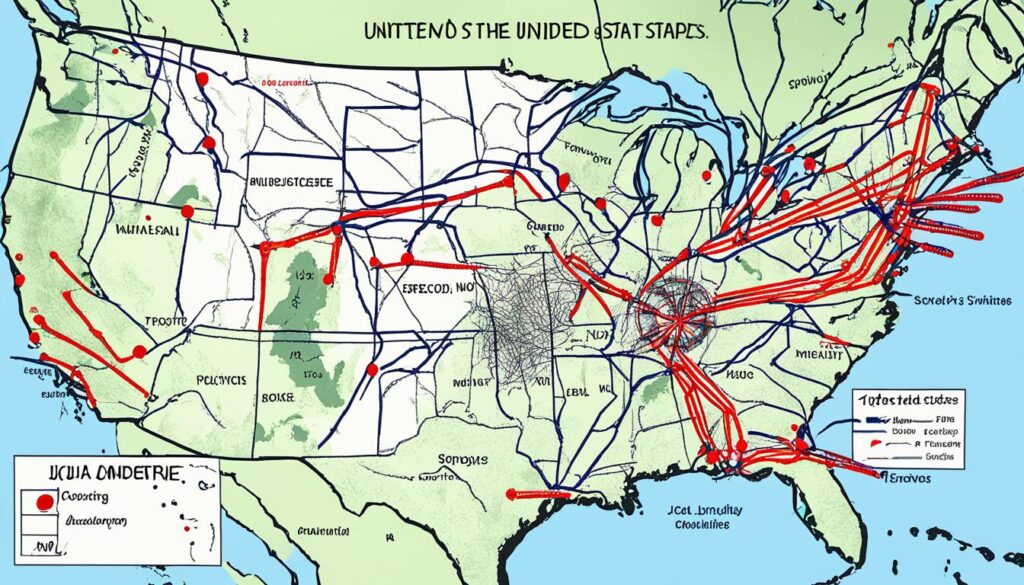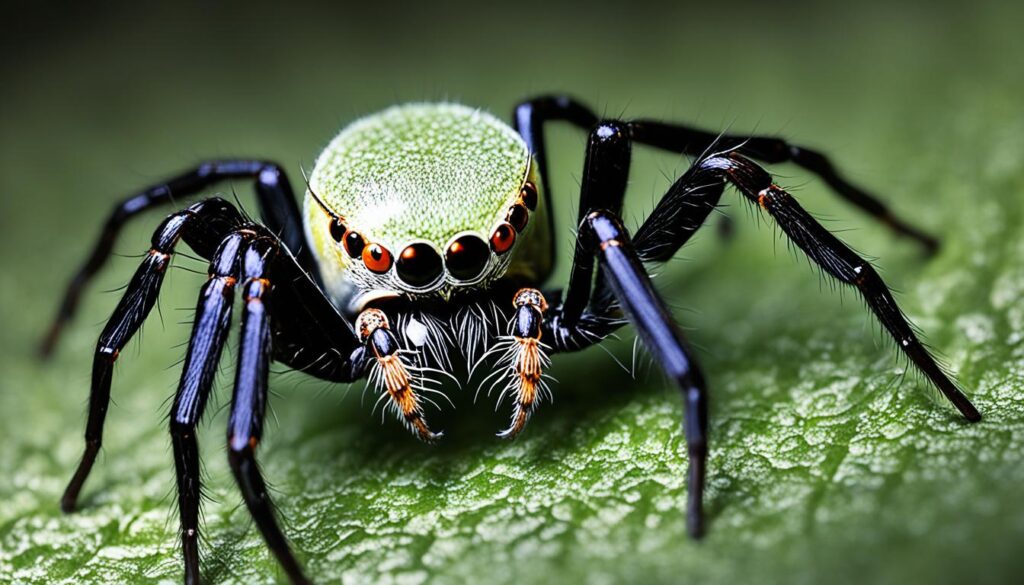
Joro Spider: Exploring the Fascinating World of This Exotic Arachnid

The Joro spider comes from East Asia and was first found in Georgia in 2013123. It’s a breathtaking invasive species that has a wide gold web. This spider has easily spread to many areas, making millions in population12.
Even though Joro spiders look scary, they are not dangerous to us2. They might bite if they feel trapped, but their fangs are usually too small to hurt people2. They can live in cities because they can handle noise and movements, they are tough and run fast
Joro spiders are actually very shy, more than any other spider researchers have seen2. They stay still for a long time when something scares them. Still, they have made a home in the U.S. and are being studied because of the way they act and the effect they have on the environment1.
Key Takeaways
- The Joro spider, an invasive species from East Asia, was first spotted in Georgia in 2013 and has since rapidly spread across the Southeast.
- Joro spiders are known for their intricate web patterns and golden silk, and their population in the U.S. has reached millions.
- Despite their intimidating appearance, Joro spiders are relatively harmless to humans and pets, with fangs likely too small to pierce human skin.
- Joro spiders have demonstrated remarkable adaptability to urban environments, tolerating vibrations, sounds, and human-dominated landscapes.
- Researchers have found that Joro spiders are the shyest spider species ever documented, remaining motionless for more than an hour when disturbed.
Introduction to the Joro Spider
The Joro spider, also known as Trichonephila clavata, is captivating and unique. It’s making headlines in the US because of its recent arrival from East Asia. This includes countries like Japan, Korea, Taiwan, and China. This spider stands out with its bright colors and skilled web-making abilities4.
Origin and Distribution
These spiders first appeared in the US around 2013. They might have come in on a shipping container5. Soon after, they were found in Georgia. Since then, they’ve spread to parts of Alabama, North and South Carolina, and Tennessee. They are now a common sight in northern Georgia6. These spiders have quickly adapted to new environments, even those near humans4.
Surprisingly, they’ve been moving outwards from where they were first seen. This has been happening at a rate of about 10 miles every year since 2014. By 2022, they have spread 50 to 80 miles in all directions. There are predictions that they could keep spreading east across the U.S. This means they might be as far as Pennsylvania in the next few decades65.
Physical Characteristics
Joro spiders are hard to miss, known for their big, yellow, and blue-black bodies. They are not the only orb spiders in America. There are others like the Yellow Garden Spider and Banana Spider, which also come from Asia4. But, the Joro stands out because of its special looks.
Compared to other orb-weavers in the US, Joro spiders are larger. They have different features from native garden spiders. These differences include their larger body size and unique web-making habits6.
| Species | Origin | Physical Characteristics |
|---|---|---|
| Joro Spider (Trichonephila clavata) | East Asia (Japan, Korea, Taiwan, China) | Large, yellow, and blue-black body; cylindrical opisthosoma |
| Yellow Garden Spider (Argiope aurantia) | Asia | Smaller body size compared to Joro spiders; less cylindrical opisthosoma |
| Banana Spider (Trichonephila clavipes) | Asia | Closely related to Joro spiders; primarily found in the Southeastern United States |
Joro Spider’s Habitat and Behavior
The Joro spider is an orb weaver with stunning golden silk. They make detailed webs to catch prey. These spiders are usually 7 to 25 mm in size7. They build their webs high, which helps them catch different kinds of insects.

Web-building Techniques
Joro spiders excel at making three-dimensional orb webs with their golden silk. Their webs are both beautiful and excellent for catching prey. They place their webs higher than most orb weavers. This could let them catch flying insects not found by others.
Prey and Feeding Habits
Joro spiders love eating brown marmorated stink bugs and other flying bugs. This diet is helpful for farmers because stink bugs can harm crops. So, Joro spiders are important for keeping pest populations in check.
Did you know? Joro spiders can travel up to 50-100 miles by spinning webs that catch the wind7. This skill helps them spread across large areas and find new homes.
Joro spiders become adults from early September to late November7. They mate, lay eggs, and die in this time. A female Joro can lay 400-1,500 eggs, making sure the species continues. The baby spiders, called spiderlings, hatch in June. They use the wind to travel to new places, sometimes for miles6.
| Spider Species | Body Length | Leg Span |
|---|---|---|
| Joro Spider (Trichonephila clavata) | 7-25 mm | 7-10 cm |
| Golden Silk Orb-weaver (Trichonephila clavipes) | 15-30 mm | 7-10 cm |
| Garden Spiders (Argiope spp.) | Up to 25 mm | Up to 6.4 cm |
Looking at the table, Joro spiders and golden silk orb-weavers are similar in size. They are both bigger than common garden spiders. Common garden spiders have small body lengths and leg spans compared to these orb-weavers6.
Experiments show Joro spiders can survive cold weather7. This could be why they’re spreading to places like northern Georgia. It is interesting to see how they adapt to new homes and the impact they have on the environment.
Joro Spider’s Impact on the Ecosystem
The Joro spider, from East Asia, came to the U.S. about eight or nine years ago. Its presence has made people wonder about its effects on the environment8. It now covers an area of at least 120,000 square kilometers, including states like Georgia and North Carolina9. Researchers believe it could spread further, impacting the U.S. East Coast. However, we’re still not sure of the full environmental impact5.
Interaction with Native Species
Experts worry about the effect of the Joro spider on local species. They’ve seen fewer native spiders since Joro spiders arrived, suggesting they might be replacing them8. Additionally, Joros eat various insects and possibly small animals. This could mess with the balance of local wildlife and ecosystems9.
Joro spiders compete with similar species for food. Their webs are higher, catching different prey. There’s also a worry they might trap pollinators, which help plants grow8. To study this, there’s a project where people count Joro and native spiders in their area8.
Potential Benefits for Farmers
Despite its threat to native species, the Joro spider might help farmers. They eat pests like stink bugs and other harmful insects9. Stink bugs can damage crops, so the Joro spider’s appetite for them is good news for farmers.
Researchers want to know more about what Joro spiders eat. They’re looking into their role in controlling pests like stink bugs and mosquitoes8. If Joros can help with pest control, they might bring some benefits to us, even though they are an invasive species.
| Potential Positive Impacts | Potential Negative Impacts |
|---|---|
| Consumption of agricultural pests like stink bugs | Displacement of native spider species |
| Reduction in mosquito populations | Catching and feeding on various insects, affecting biodiversity |
| Benefits for farmers through pest control | Presence of pollinators in Joro webs |
The Joro spider’s spread through the U.S. is ongoing. This happens through nature and possibly with human help59. Some people kill these spiders, but this can harm native species. The question of whether Joro spiders are good or bad needs more study8. It’s a complex issue that depends on many factors.
Joro Spider’s Venom and Bite
Many worry about spider bites, but not all spiders are a big danger. The Joro spider is catching attention due to its looks and quick spread in the southeast of the US. Though it’s venomous, its bite is not that harmful to humans. Researchers say they rarely bite unless bothered10.
Venomous Nature of Spiders
All spiders, like the Joro, have venom to catch food not to harm us or pets11. The Joro spider is big, the size of a palm, and its venom is mainly for insects10.
Compared to brown recluse or black widow spiders, the Joro spider’s venom is mild. It’s hard for its fangs to pierce human skin, lowering the risk of a serious bite.
Risks to Humans and Pets
Joro spiders are not a big threat to humans or pets11. They are shy and only bite if they feel trapped10. The University of Georgia found the Joro spider to be very shy; it freezes when disturbed for over an hour10.
If a Joro spider bites, it feels like a bee sting. It’s minor and won’t cause lasting harm10.
| Spider Species | Venom Potency | Risk to Humans |
|---|---|---|
| Joro Spider | Low | Minimal |
| Brown Recluse | High | Significant |
| Black Widow | High | Significant |
As the Joro spider spreads, understanding its bite is key. It’s less risky than thought. Learning about it helps us not fear these amazing spiders.
Studying the Joro Spider’s Spread in the United States

Researchers at the University of Georgia are hard at work. They’re studying how the Joro spider is quickly spreading across the United States. This spider was first seen in northern Georgia in 2014. Since then, it has spread over 120,000 square kilometers. It now includes states like Georgia, South Carolina, North Carolina, and Tennessee. Further sightings in Alabama, Maryland, Oklahoma, and West Virginia have been reported as of October 20229. By this summer, the Joro spider is expected to reach New Jersey and New York. This will increase its presence in the Southeast12.
A deeper study has found the Joro spider may soon be found all over the eastern U.S. The research predicts the spider’s range will keep moving north. The Joro’s spread is mostly due to how they move between places with the help of the wind. They do this by letting out silk that catches the wind and carries them, a process known as ballooning. It’s possible people have also helped them spread912.
The University of Georgia’s research is sharing some amazing insights. For example, they found as many as 50 Joro spiders in a 94-yard area. This means there was about one Joro spider every two yards. With so many of them around, they are pushing out local spider species and causing problems for the local environment9.
A recent study found that Joro spiders are “here to stay” in the U.S. and will rapidly expand their range across the country12.
Joro spiders look scary with their body size around four inches and big, six to eight-inch legs. But, they are not dangerous to people or pets. They mainly eat flying insects like mosquitoes, yellowjackets, stink bugs, and spotted lanternflies. This might actually help the area by controlling these harmful bugs12.
How the Joro spiders affect local spiders is complex. They might hurt some other spiders but help control insects. However, it’s hard to manage them because they live in both wild areas and near people9.
As the University of Georgia’s work continues, we’re learning more. The Joro spider has firmly established its place in the U.S. Now, we need to better understand how it lives, moves, and interacts with other species. This knowledge will be key to managing the Joro spider in the future.
Joro Spider’s Tolerance to Urban Environments
The Joro spider is an invasive species from East Asia. It has shown an amazing ability to live in urban areas since it got to the Southeastern United States13. They make their webs near busy roads, power lines, and even gas stations. This shows they can handle the noise and activity of our cities.
Adaptation to Vibrations and Noise
A study in northeastern Georgia found that Joro spiders are doing well despite living near loud roads1314. They kept their health and weight even with all the noise and movement around them. This team did 357 experiments and found that spiders near quieter roads caught prey more often14. This small change in hunting frequency shows Joro spiders can adapt to urban life13.
Successful Colonization of Human-dominated Landscapes
Joro spiders have not just survived but made new homes in our cities13. In Georgia, they are in places where local spiders don’t live, showing their amazing ability to move into our spaces15. They are as healthy near busy roads as they are in quieter areas. This proves they are indeed very tough15.
Joro spiders in the U.S. have grown quickly, reaching millions in number. They are quick, stand cold well, and adapt easily to city life15. These qualities help them spread across the Eastern Seaboard. With the females laying many eggs in the late summer and fall, their numbers keep growing. This means they will be in our cities for a long time13.
Joro Spider’s Remarkable Shyness
Joro spiders have a standout feature: they are very shy. Even though they look bold and have quickly spread across the southeastern United States, these spiders don’t like being disturbed. A 2023 study from the University of Georgia found something interesting. When Joro spiders face small disturbances, they freeze up for more than an hour, showing how shy they are16.

Comparison to Other Spider Species
More than 450 spiders from 10 species were part of a study. It pointed out the Joro spider’s unique reaction17. After a light disturbance, most spiders stayed still for just under a minute. But Joro spiders and their cousin, the golden silk spider, stayed motionless for over an hour17.
This might be because of city life. Joro spiders could freeze to avoid noise, movement, and even sights17. The University of Georgia also found they can handle loud sounds and stress. They even build their webs on busy spots like telephone poles and traffic lights16.
Joro spiders keep spreading across the southeast since they arrived in 2013. They are now in the millions. Studying their shyness could teach us a lot about how invasive species like them adapt to living near us. Plus, how they affect the spiders that were already living here17.
Joro Spider’s Invasive Potential
The Joro spider comes all the way from East Asia. It first showed up in the United States about 20135. Since then, it has quickly taken over places like Georgia and the Southeast. Millions of these spiders now call this area home. Their quick takeover is mainly due to their ability to reproduce fast and survive the cold. This means they spread a lot, not because they are mean or kick out the local spiders.
Rapid Spread and Population Growth
The female Jorō spider lays a lot of eggs before winter comes. She can lay up to 400 eggs! After laying her eggs, the mother spider dies18. These eggs hatch in spring. The baby spiders make webs that let them fly up to 100 miles away from where they started. This flying ability helps them spread out fast. They have a quick heart rate and metabolism, which means they grow in number rapidly. This is also thanks to their unique heart rate, which is 77% higher than their cousin, the golden silk spider5.
They were first seen around Atlanta, Georgia, in 2014. Now, they are not only in Georgia but also in South Carolina, North Carolina, and Tennessee. People have even seen them in Alabama, Maryland, Oklahoma, and West Virginia. They likely came to the U.S. as stowaways on big ships. There’s a big chance they’ll keep spreading because humans can move them too, by accident, in cars or luggage5.
Ability to Withstand Colder Climates
The Joro spider is good at living in cold places. It can survive a quick freeze that other types of spiders can’t. This ability shows that it might spread even further than just the Southeast. With their tolerance for the cold helping them move fast, it’s possible they could take over a big area on the Eastern Seaboard.
Joro spiders might grow in numbers a lot. They could end up fighting with local spiders for food and space. However, they’re not harmful to people or pets. Their biggest issue is just being a bit of a bother, not a danger518.
Coexisting with Joro Spiders
The Joro spider is making itself at home in the U.S., starting in Georgia in 2014. It’s now moving to nearby states in the Southeast and might travel north. This spider, known for its big size – some reaching up to 3 inches – is not a threat. Studies show they are calm and avoid people1920.
Observing and Learning from Joro Spiders
Kicking Joro spiders out of your area is almost impossible, like trying to clear a beach of sand. Instead, experts say, we should watch and learn from them. We can understand more about them by looking at their webs and what they eat20. They help by catching and eating harmful bugs. They even get along with other spiders, sometimes sharing their webs20.
Avoiding Unnecessary Killing of Spiders
Every spider, Joro included, is important for the environment. Instead of killing them, experts urge us to leave them alone or move them gently. Joro spiders aren’t dangerous to us, and you can scare them off with a broom1920. By not hurting them, we learn more about these unique creatures. This approach helps us all live together better20.
FAQ
What is a Joro spider?
When did the Joro spider arrive in the United States?
Are Joro spiders dangerous to humans or pets?
How do Joro spiders build their webs?
What do Joro spiders eat?
How do Joro spiders impact the ecosystem as an invasive species?
Can Joro spiders thrive in urban environments?
Are Joro spiders shy?
Could Joro spiders spread beyond their current habitats?
Should we kill Joro spiders when we see them?
Table of Contents
Source Links
- https://www.sciencedaily.com/releases/2024/02/240213130416.htm
- https://phys.org/news/2023-05-massive-joro-spiders-gentle-giants.html
- https://phys.org/news/2022-03-huge-spiders-colonize-east-coast.html
- https://jorospider.com/joro-spiders-as-an-immigrant/
- https://news.uga.edu/joro-spiders-likely-to-spread-beyond-georgia/
- https://extension.psu.edu/joro-spiders
- https://www.orkin.com/pests/spiders/joro-spiders
- https://www.gpb.org/news/2022/08/18/how-do-joro-spiders-impact-the-ecosystem-uga-researchers-hope-find-out-maybe-your
- https://news.clemson.edu/clemson-scientist-study-shows-joro-spiders-are-here-to-stay-spreading-fast/
- https://www.forbes.com/sites/antoniopequenoiv/2024/06/04/will-giant-flying-spiders-really-invade-new-york-the-joro-explained/
- https://www.newsnationnow.com/us-news/strange/joro-spiders-giant-flying-east-coast/
- https://www.nbcnewyork.com/news/local/giant-parachuting-joro-spiders-coming-to-ny-nj-summer/5473909/
- https://www.earth.com/news/menacing-joro-spiders-are-now-moving-their-invasion-into-us-cities
- https://www.smithsonianmag.com/smart-news/joro-spiders-spreading-in-the-southeast-can-survive-surprisingly-well-in-cities-180983845/
- https://news.uga.edu/joro-spiders-poised-to-populate-cities/
- https://www.forbes.com/sites/antoniopequenoiv/2024/06/04/will-giant-flying-spiders-really-invade-new-york-the-joro-explained
- https://www.earth.com/news/joro-spiders-they-may-be-massive-but-they-are-gentle-giants
- https://www.livescience.com/animals/spiders/giant-invasive-joro-spiders-with-6-foot-webs-could-be-poised-to-take-over-us-cities-scientists-warn
- https://mashable.com/article/spider-joro-spread
- https://news.uga.edu/joro-spiders-are-here-to-stay/
- https://www.washingtonpost.com/climate-environment/2024/06/05/giant-joro-spiders-venomous-new-york/
Author Profile
Latest entries
 Blogjulio 7, 2024Lakers vs Kings: NBA Showdown Preview
Blogjulio 7, 2024Lakers vs Kings: NBA Showdown Preview Blogjulio 7, 2024Nate Diaz vs Masvidal: UFC Grudge Match Preview
Blogjulio 7, 2024Nate Diaz vs Masvidal: UFC Grudge Match Preview Blogjulio 6, 2024when was caleb martin drafted
Blogjulio 6, 2024when was caleb martin drafted Blogjulio 6, 2024Khyree Jackson Car Accident: What Happened?
Blogjulio 6, 2024Khyree Jackson Car Accident: What Happened?




Average Rating